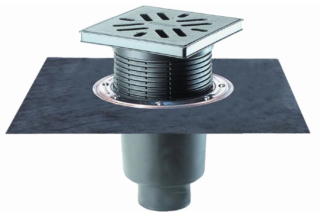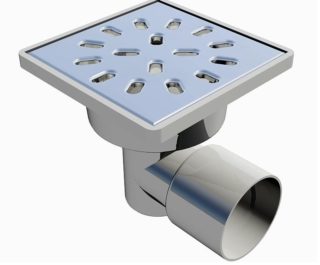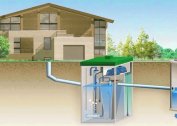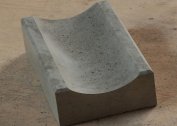Drainage ladder - plumbing equipment that is mounted on the floor to ensure the discharge of dirty water into the sewage system. Thanks to the use of this device in the domestic sphere, the complete isolation of the sewage system is provided, and it also becomes possible to implement various design solutions for the shower enclosure.
Definition and purpose of the sewer
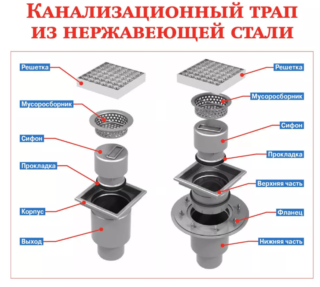 The drain ladder is one of the most popular drainage devices. It is used to receive wastewater from the horizontal surface of the shower floor without a tray and to discharge it into the sewer. The element is used in industrial, public and residential premises. The gangway performs several functions due to its design:
The drain ladder is one of the most popular drainage devices. It is used to receive wastewater from the horizontal surface of the shower floor without a tray and to discharge it into the sewer. The element is used in industrial, public and residential premises. The gangway performs several functions due to its design:
- quickly and efficiently remove wastewater;
- filter contaminated liquid from large debris;
- combine plumbing equipment with a fluid drainage system;
- prevent odor from entering the room.
Until recently, the drain was represented by products with a hydraulic shutter - a curved tube filled with liquid. Unpleasant odors cannot penetrate such an obstacle. The disadvantage of these devices is that the water periodically dries up (due to rare use, the presence of underfloor heating), and the air from the sewage system freely enters the room. Sewer drains with a water trap require a lot of space for installation and they must be regularly spilled with water.
In addition to hydraulic locks, ladders equipped with a dry shutter become popular. Such elements do not allow unpleasant odors to go beyond the sewer system and do not require frequent maintenance.
Requirements for sewer ladders are specified in GOST 1811-97. This standard applies to cast iron and plastic products installed in rooms for various purposes.
Application area
Sewer drains have a wide scope. They are used in the medical, food and chemical industries. Devices are installed in livestock buildings.
Sewer ladders are used to create a sewage system of apartments and houses. Installed in heated buildings and structures without a heat supply system. Drain devices are mounted in sanitary facilities of educational institutions and catering establishments.
Types and arrangement of sewer ladders
Gutter drain devices are distinguished depending on the material of manufacture and the characteristics of the installation. Most popular products:
- Plastic sewer drains are used even in sanitary facilities. They have a long service life and are not exposed to aggressive environments. Due to its light weight, plastic closures are easy to install. In addition, devices can be decorated with gratings - removable or non-removable.
- Cast iron is often placed in large industrial buildings. Devices are suitable for toilets, pools and laboratory rooms. The advantages include durability and high throughput. The heavy weight of such drains makes installation difficult.
- Steel products are better than others for medical and research institutions, since they meet the high requirements of sanitary standards. Stainless steel sewers are easier to install and easier to clean.
According to the type of installation, the valves are divided into the following types:
- Vertical. They are distinguished by high throughput and are used when supplying sewage.
- HorizontalIt is convenient to use in apartments and private houses. The drain is connected to the pipes through a side supply.
Sewer drains are distinguished by the shape of the upper grate, which can be square, angular, rectangular and round. Devices for showers are adjustable. Such systems allow you to change the length of the drain so that it matches the thickness of the floor covering.
Sewer device:
- The receiving funnel is the outer casing of the device, which removes water and provides its discharge. Due to the presence of a flange, the fastening of the waterproofing floor membrane is tight.
- Siphon with removable grill, which is built into the housing. The element protects the sewer system from large debris. The siphon water trap does not allow gases to enter the wastewater system into the shower room. Some models have a mechanical or dry shutter.
- At the bottom of the housing there is an outlet with a coupling. Thanks to it, the device is connected to the sewer pipe.
The ladder has clamping and sealing elements. Of great importance for the functioning of the drainage system is the tightness of the device. Before buying a product, you should assemble it and check the tightness of the fit of the various components.
Selection recommendations
When choosing a dry sewer, it is recommended to pay attention to the following points:
- Decide on the number of risers. For a private house or apartment, you should choose a shutter with a conditional passage (DN) of 50 mm.
- A product with horizontal outlet can be installed in a limited space. Its height varies in the range of 6-10 cm. Models with a vertical outlet require 15-18 cm. Before installation, it is worth taking measurements and finding out which shutter is suitable for the shower in a particular case.
- Before buying a sewer, it is recommended to check the serviceability of all its components and the functionality of the device (pouring water from the bottle).
- Clarify the size of the product based on the volume of effluents. For a shower cabin, it is enough to purchase a ladder with medium parameters and good throughput.
After clarifying the technical characteristics of the drain, you can pay attention to its appearance.
Mounting Features
Lattices are brought out to the level of a floor covering. Grouting is done with moisture resistant material. The outlet pipes are installed at a slope of 0.1% with respect to the length. The screed is removed when installing the draining funnels. It is equally important to seal every joint and all joints, to perform heat and waterproofing.
Features of the installation of the drain in the shower room:
- The thermal barrier is placed in a circle of plumbing ladders.
- When creating extensions, they constantly monitor the slope of the pipes. After completion of the work, raw concrete is leveled and tiles are laid on it.
- In order for the water flows to the gangway, it is necessary to slope the flooring in the desired direction by at least 150 mm.
- From the bottom, polystyrene foam is laid from 40 to 50 mm thick. Thermal insulation reduces noise and prevents heat loss.
- A rough screed is performed, for which you will need to pour another 4 cm of concrete mortar. A waterproofing membrane is laid on it, and then a screed and ceramic tile forming a slope.
- Lining the walls is carried out only after laying, which allows to achieve the optimal level of waterproofing.
When choosing a drain device, it is worth paying attention to the durability of the material from which it is made, as well as taking into account the features of its use in the future.
